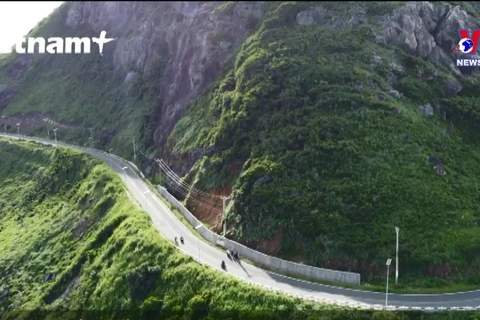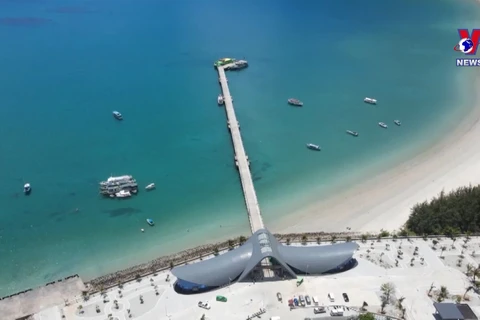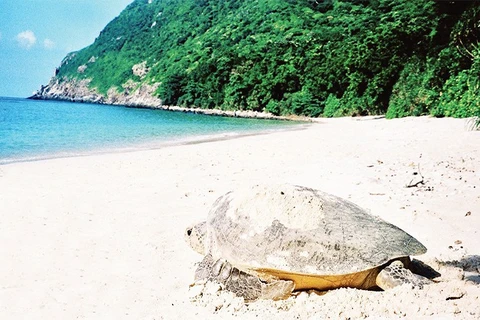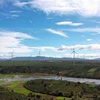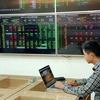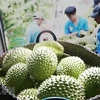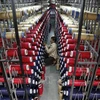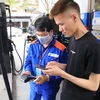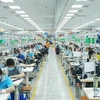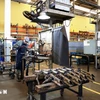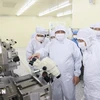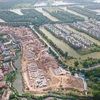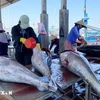Ba Ria-Vung Tau (VNA) – Circular economy has helped gradually solve existing problems and challenges related to the environment and energy faced by Con Dao island, creating a breakthrough to help the district in the southern province of Ba Ria-Vung Tau develop a green and sustainable economy.
The concept of a circular economy is relatively new in Vietnam but the southern province of Ba Ria-Vung Tau embarked on a circular economy development plan right from the beginning of the 2021-2025 economic development period, and Con Dao Island was the first district to implement the economic model.
Increasing awareness of people, tourists on environmental protection
According to statistics of the People's Committee of Con Dao district, currently, waste from daily activities and tourism on the island is estimated at about 25 tonnes per day, of which plastic waste accounts for nearly 2 tonnes, while the treatment capacity of the waste treatment plant in the locality is only about 10 tonnes a day.
Therefore, circular economy has been selected by the provincial People's Committee as a solution to promote the strengths as well as solving the challenges of Con Dao, with the emphasis placed on the harmonious relationship between the ecological environment, social justice and economic development. On that basis, the provincial Department of Science and Technology was assigned to build the project on “Research and application of the circular economy model for sustainable socio-economic development of Con Dao district in the 2021 – 2026 period, with a vision to 2030”.
The project, approved on March 16, 2023, aims to achieve the rate of domestic solid waste and organic waste collected and treated through circular economy models in Con Dao by 2030 to reach 50% and100%, respectively. The rate of rainwater collection and treatment for domestic use will reach 10%, the area for planting and restoring coral reefs will be increased to 6-7ha, and the percentage of vehicles using electricity and green energy will hit 30%.
Nguyen Hong Quan, Director of the Institute for Circular Economy Development under the Vietnam National University, Ho Chi Minh City which is in charge of consulting the project, said that one of the project’s important solutions is to build a system of managing waste from daily and tourism activities in accordance with circular economy regulations. Accordingly, waste will be sorted, collected and transported to treatment facilities where it will be recycled, reused or converted into energy or fertiliser. Products from waste will be reused for production activities in agriculture and daily life of Con Dao, helping to reduce dumped waste and save resources.
Huynh Trung Son, Vice Chairman of the Con Dao district People's Committee, said that Con Dao has stepped up dissemination about the awareness of keeping general sanitation and protecting the environment, and launched a movement to collect, sort, recycle and treat plastic waste at the source in the community and at tourist sites. As a result, the awareness of residents and visitors of keeping sanitation has been significantly improved.
Circular economy in all fields
Quan said that circular economy solutions must be associated with business models to increase the feasibility of the project and attract more investment from all social sectors.
For example, organic waste can be converted into fertiliser which will be provided for the agricultural sector, or processed plastic waste can be reused into handicraft products and 3D paintings as souvenirs for tourists, he said.
Son shared that the district is completing a project to build a centralised wastewater treatment plant whose phase 1 has a treatment capacity of 1,000 cu.m a day to ensure the quality of the output water can be used for agricultural irrigation. In phase 2, by 2030, its treatment capacity can reach 3,500 cu.m a day.
In addition, the district will also invest in building a centralised wastewater collection system from households and residential areas, and rainwater collection systems for small islands to produce drinking water and serve tourism activities, with a capacity of 500 litres per day per island.
The project also proposes other solutions to develop circular economy for other fields such as agriculture, tourism, industry and services./.


